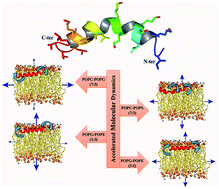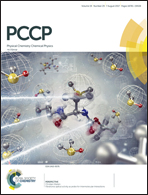Abstract
Multidrug resistance against the existing antibiotics is one of the most challenging threats across the globe. Antimicrobial peptides (AMPs), in this regard, are considered to be one of the effective alternatives that can overcome bacterial resistance. MSI-594, a 24-residue linear alpha-helical cationic AMP, has been shown to function via the carpet mechanism to disrupt bacterial membrane systems. To better understand the role of lipid composition in the function of MSI-594, in the present study, eight different model membrane systems have been studied using accelerated molecular dynamics (aMD) simulations. The simulated results are helpful in discriminating the particular effects of cationic MSI-594 against zwitterionic POPC, anionic POPG and POPS, and neutral POPE lipid moieties. Additionally, the effects of various heterogeneous POPC/POPG (7 : 3), POPC/POPS (7 : 3), and POPG/POPE (1 : 3 and 3 : 1) bilayer systems on the dynamic interaction of MSI-594 have also been investigated. The effect on the lipid bilayer due to the interaction with the peptide is characterized by lipid acyl-chain order, membrane thickness, and acyl-chain dynamics. Our simulation results show that the lipid composition affects the membrane interaction of MSI-594, suggesting that membrane selectivity is crucial to its mechanism of action. The results reported in this study are helpful to obtain accurate atomistic-level information governing MSI-594 and its membrane disruptive antimicrobial mechanism of action, and to design next generation potent antimicrobial peptides.



 Please wait while we load your content...
Please wait while we load your content...